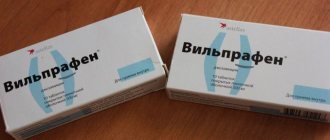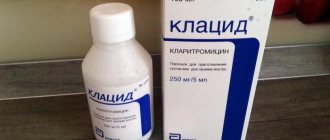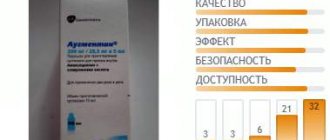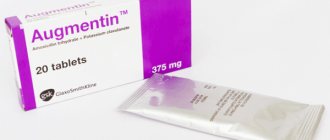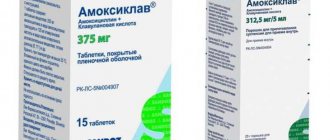- December 25, 2019
- Infectious
- Evgenia Yushkova
"Ospamox" is an antibacterial drug with a wide spectrum of antimicrobial activity. It is well tolerated by patients, and adverse reactions after taking it are minimal. The drug is easy to use, as it is available in various dosage forms.
Pharmacological group
In terms of its effect on microorganisms, this antibiotic belongs to the category of broad-spectrum semi-synthetic penicillins. The main active ingredient has a pronounced bactericidal property and is active against most gram-positive aerobic (oxygen-requiring) and gram-negative anaerobic (oxygen-not requiring) microorganisms. Bacteria capable of secreting penicillinase are constant to the drug.
When used in combination with Metronidazole, it is effective in destroying the bacterium Helicobacter pylori. Combines well with clavulanic acid, significantly expanding its spectrum of action.
When used orally, the active substance is completely and in a short period of time absorbed into the blood, without being damaged inside the gastrointestinal tract and without changing its therapeutic direction. Its highest concentration in plasma is recorded 1-2 hours after entering the body. As the dose increases, the levels of the active component in the blood increase accordingly.
About 60% of the drug substance is excreted in the urine in its original composition. A small amount is concentrated in the feces. It is completely eliminated from the body by hemodialysis.
Drug interactions
Combination therapy of Ospamox with the following drugs is not recommended:
- Allopurinol: the appearance of an allergic skin rash;
- Digoxin: increased absorption (dose adjustment may be required);
- Coumarin anticoagulants: prolongation of bleeding time (dose adjustment may be required; risk factors include inflammatory and infectious processes, general condition and age of the patient);
- Methotrexate: increased toxicity (if combined use is necessary, careful monitoring of serum methotrexate levels is necessary).
The combination of oral hormonal contraceptives with Ospamox requires caution due to the decrease in plasma levels of progesterone and estrogens, as well as the effectiveness of oral contraceptives (the use of additional non-hormonal contraceptive measures is recommended).
Forced diuresis can lead to a decrease in the concentration of Ospamox in the blood (due to intensive excretion).
Amoxicillin may interfere with the colorimetric determination of proteins.
To test for the presence of glucose in urine during amoxicillin therapy, it is recommended to use the enzyme glucose oxidase method. When using chemical methods, frequent false-positive reactions are possible, which is due to the high concentration of amoxicillin in the urine.
High concentrations of amoxicillin may lower serum glycemic levels.
Release forms and their composition
Ospamox is produced in several forms, united by the presence of the same active substance - amoxicillin. Depending on the general health of the patient, age and severity of the disease, the doctor determines one or another type of medication for treatment:
- Tablets in a thin film package are yellowish-white in color, convex oval in shape with notches on both sides. Sold in a cardboard box of 2 records for 6 pieces. Each unit contains 500 or 1000 mg of the main component and a number of additional ones (magnesium stearate, polyvidone, sodium starch glycolate, microcrystalline cellulose). The structure of the outer film contains talc, titanium dioxide, and hypermellose.
- Capsules for oral administration containing 250 mg of the main active ingredient, sealed in a cardboard pack of 10 blisters of 10 pieces.
- Powders (granules) for diluting the suspension in dark glass bottles of 60 ml, each in a separate cardboard package with a measuring syringe and a spoon inside. They have a light yellow color and a pronounced fruit aroma. The finished mass has a bitter-sweet taste with a fruity aroma. 5 ml of the prepared mixture contains 125, 250 or 500 mg of the main component, citric acid, sodium benzoate, aspartame, talc, guar gum, silicon dioxide, trisodium citrate, fruit flavors.
All forms of Ospamox are intended for oral administration. In accordance with the instructions for use of Ospamox 500, 250 or 125 mg, the suspension must be prepared before administration. The choice of one or another form of medication is related to the dosage and ease of use by patients.
Compound
Ospamox capsules contain the active ingredient amoxicillin (250 mg).
The tablets contain the active ingredient amoxicillin (500 mg or 1000 mg). As auxiliary elements, the product contains polyvidone, magnesium stearate, sodium starch glycolate, talc, MCC, titanium dioxide, methylhydroxypropyl cellulose.
Ospamox granules contain the active ingredient amoxicillin (125 mg or 250 mg). As excipients, the composition contains sodium saccharin, simethicone, trisodium citrate anhydrous, guarana (gum), sodium benzoate, sucrose, flavoring.
Photo of “Ospamox” 1000 mg and 500 mg (tablets), mixture for stirring the suspension
The Ospamox suspension contains the amount of active ingredient corresponding to that indicated on the package: 125, 250 or 500 mg. Inside there is a bottle of powder or granules and a description of the use of the drug.
Instructions for using Ospamox 500 mg tablets are included in the package, and there are also two blisters with the drug. Each contains 6 tablets.
Instructions for the use of Ospamox 1000 mg tablets and two strips of tablets are included in the box with the drug of this dosage.
Regardless of the form, the drug acts effectively on all types of microorganisms that are sensitive to the main substance – amoxicillin.
During pregnancy and lactation
Since amoxicillin can cross the placenta, during pregnancy this drug is prescribed only after comparing the likely benefits and harms.
It is found in breast milk in small quantities. There is a possibility that a breastfed baby may experience highly sensitive reactions. Therefore, Ospamox can be used during lactation only after careful comparison of the likely risks and benefits. If the child has had gastrointestinal disorders, breastfeeding should be stopped.
Indications for use
In accordance with the instructions for use, “Ospamox 1000 mg” affects all types of microbes that are not resistant to amoxicillin. First of all, these are bacteria that cause the following diseases:
- pathologies of the upper and lower respiratory tract, ear, nose and throat (otitis media, sinusitis, community-acquired pneumonia, acute chronic bronchitis, tonsillitis, tracheitis, laryngitis);
- problems with the urinary system (cystitis, pyelonephritis, urethritis);
- the initial phase of Lyme disease;
- disorders of gynecological organs and systems;
- gastrointestinal infections (cholecystitis, cholangitis);
- furunculosis;
- gonorrhea;
- endocarditis (for preventive purposes);
- ulcer caused by the bacterium Helicobacter pylori (in adult patients in complex therapy with wound-healing drugs).
Only the attending physician can prescribe the drug. He will determine the dosage and number of medication doses, taking into account the patient’s age, his well-being and diagnosis.
Side effects of the drug Ospamox
Gastrointestinal tract: nausea, loss of appetite, vomiting, bloating, diarrhea, dry mouth, taste disturbance; rarely - tooth discoloration (especially when using a suspension), which disappears after brushing the teeth; very rarely - coloring of the tongue black. Liver and biliary tract: moderately pronounced and transient increase in the activity of hepatic transaminases. Hypersensitivity reactions: adverse reactions from the skin, such as exanthema, itching, urticaria; the immediate appearance of urticaria after taking the drug indicates the presence of an allergic reaction to amoxicillin, and therefore treatment with Ospamox should be discontinued. Rarely - erythema multiforme, maculopapular rash; serum sickness, allergic vasculitis, Steven-Johnson syndrome, bullous and exfoliative dermatitis; in some cases - toxic epidermal necrolysis, anaphylactic shock, angioedema. Nervous system: hyperkinesia, dizziness, convulsions. Seizures may occur in patients with renal failure or in those using the drug in high doses. Urinary system: rarely - development of interstitial nephritis. Hematopoietic system: rarely - agranulocytosis, thrombocytopenia. General disorders: drug fever has been rarely reported; prolonged or repeated use of the drug may lead to the development of superinfections and colonization of persistent microorganisms or yeasts that cause oral or vaginal candidiasis.
Instructions for use
The instructions for use of Ospamox 500 mg and 1000 mg tablets contain the necessary data on the frequency and dosage of use. Tablets and capsules are swallowed without chewing, washed down with a sufficient amount of water. Taking the drug does not affect meal periods. If the doctor has prescribed a suspension, it is first prepared: opening the bottle, filling it with drinking water, without adding 1 cm to the top, shaking thoroughly. Then the prepared mixture is measured out with a special syringe, swallowed, and washed down with water.
The dosage is calculated in accordance with the instructions for use of Ospamox tablets, based on the patient’s body weight, age, renal function and urinary tract, severity of the condition and group of the infectious agent. Following the recommendations of specialists, treatment should be continued for another 2-3 days until symptoms disappear. If we are talking about the destruction of streptococcal infection - 6-10 days.
Adult patients and children weighing more than 40 kg receive 1500-2000 mg daily in 2-3 doses. Next, the measure is determined based on the diagnosis:
- in case of acute sinusitis, cystitis, pyelonephritis - 250-500 mg 3 times a day or 750-1000 mg 2 times;
- for acute otitis, tonsillitis, pharyngitis and chronic bronchitis in the acute stage - 500 mg every 8 hours or 750-1000 mg every 12 hours for 10 days;
- for community-acquired pneumonia – 500-1000 mg every 8 hours;
- in case of acute infection of the gastrointestinal tract and biliary system - 500-2000 mg per day in 3 doses or 1000-1500 mg in 4 doses;
- for Lyme disease - 500-1000 mg three times a day for the first 2-3 weeks;
- for eradication (destruction) of Helicobacter pylori - 750-1000 mg twice a day in combination with Clarithromycin and Omeprazole (Lansoprazole) for a period of 1-2 weeks;
- for the prevention of endocarditis - 2000-3000 mg 1 hour before surgery (if necessary, a repeat dose should be administered after 8-9 hours).
In severe cases of the disease, the daily dose can be increased to 6000 mg.
Special instructions in the instructions for use of Ospamox tablets apply to the treatment of small patients.
For children weighing up to 40 kg, the average daily dose is 20-90 mg/kg. It depends on the nature of the disease and the sensitivity of microorganisms to the effects of the drug. Maximum values – up to 100 mg/kg per day in 2-3 doses. The doctor himself calculates the treatment regimen depending on weight, diagnosis and course of the disease:
- in the treatment of sinusitis, otitis media, acute pyelonephritis, as well as community-acquired pneumonia - 20-90 mg/kg/day in 2-3 doses;
- in the treatment of streptococcal tonsillitis and pharyngitis – 40-90 mg/kg/day;
- for gastrointestinal infection - 100 mg/kg/day;
- for the prevention of endocarditis – 50 mg/kg 1 hour before the intervention;
- for Lyme disease - 25-50 mg/kg/day 3 times a day for the first 2-3 weeks.
Most often in pediatrics, the suspension form is used, since it is easier for the child to take it orally. Average daily rates for using the suspension vary depending on the age of the child:
- for children under 1 year - Ospamox suspension 125 mg/5 ml - 2.5-5 ml;
- for children 1-3 years old - the same suspension with a dosage of 250 mg/5 ml - 2.5-5 ml;
- for children 3-6 years old - Ospamox suspension 250 mg/5 ml - 5-7.5 ml each;
- for children 6-10 years old - a suspension of this drug with a dosage of 500 mg/5 ml - 2.5-5 ml;
- for children 10-14 years old - Ospamox suspension 500 mg/5 ml - 5-7.5 ml each.
The specified amount of the drug is divided into 2 doses. It is not recommended to dilute the dry mixture with milk, tea or juice. It is best to dilute with drinking water. Then you can give your baby something tasty to wash it down with. Children weighing more than 40 kg take adult doses of the medicine.
When diagnosing functional renal disorders in patients, the daily dosage is reduced by reducing the frequency of use of the drug. In case of pathologies of the excretory system, the process of excretion (the release of end products of metabolism from the human body) of amoxicillin slows down. This may lead to intoxication. Typically, reducing the dose or frequency of medication will solve this problem.
Ospamox (powder/granules for suspension)
Name: Ospamox (powder/granules for suspension preparation) (Ospamox) Pharmacological action: Ospamox is an antimicrobial drug from the group of beta-lactam antibiotics. Ospamox contains the active component - amoxicillin - a semi-synthetic substance of the aminopenicillin group, which are representatives of the penicillin series of antimicrobial drugs. Ospamox is a broad-spectrum antibiotic with a pronounced bactericidal effect. The mechanism of action of the drug is based on its ability to inhibit the synthesis of peptidoglycan, which forms the basis of the bacterial cell membrane. Inhibition of the synthesis of this biopolymer occurs due to the ability of amoxicillin to influence penicillin-binding proteins, which act as enzymes in the process of peptidoglycan synthesis. Due to disruption of the structure of the cell membrane, its destruction and lysis of microorganisms occurs. The drug Ospamox does not have specific toxicity towards the macroorganism, since penicillin-binding proteins and peptidoglycan are absent in the mammalian body. The drug has a wide spectrum of action, in particular it is effective in the treatment of diseases caused by the following microorganisms: Gram-positive aerobic bacteria: Streptococcus spp. (including Streptococcus pneumoniae), Staphylococcus spp. (except for strains producing beta-lactamase). Gram-negative aerobic bacteria: Neisseria meningitidis, Neisseria gonorrhoeae, Escherichia coli, Salmonella spp., Shigella spp., Klebsiella spp., Haemophilus influenzae, Proteus mirabilis, Actinomycetes spp., Bordetella pertussis, Corynebacterium spp., Campilobacter spp., Bacillus anthracis, Listeria spp., Erysipelothrix rhysiopathiae, Pasteurella multocida, Spirillum minus, Spirochaeta (Leptospira, Treponema, Borrelia) and Streptobacilli spp. Gram-negative anaerobic microorganisms: Fusobacter spp., Peptostreptococcus spp., Peptococcus spp., Clostridium spp.
Strains producing beta-lactamases (in particular penicillinase) are not sensitive to the drug, since amoxicillin is destroyed by penicillinase. After oral administration, amoxicillin is rapidly absorbed from the gastrointestinal tract, absorption occurs mainly in the small intestine, the bioavailability of the drug is about 75-90%, depending on the dose. Absorption of the drug does not depend on food intake. The maximum plasma concentration of amoxicillin is achieved within 1-2 hours after a single use of the drug. The degree of binding to plasma proteins is low (no more than 17%). The drug penetrates well into tissues and biological fluids of the body, including clinically significant concentrations of amoxicillin observed in sputum and bronchial secretions. The drug penetrates well through the hematoplacental barrier and creates high concentrations in the amniotic fluid and fetal tissues. A small amount of amoxicillin is found in breast milk. Amoxicillin penetrates the blood-brain barrier poorly; in patients suffering from meningitis, the concentration of the drug in the cerebrospinal fluid is about 20% of the dose taken. In patients with normal liver function, high concentrations of the drug in bile are observed. From 7 to 25% of the drug is metabolized in the body with the formation of a pharmacologically inactive metabolite - penicillic acid. The drug is excreted primarily in the urine (about 60-80%), both unchanged and in the form of metabolites, the rest of the dose is excreted in bile. The half-life in patients with normal renal function is 1-1.5 hours, in patients suffering from renal failure - from 5 to 20 hours. Amoxicillin is eliminated during hemodialysis.
Indications for use: The drug is used in the treatment of patients suffering from diseases caused by microorganisms sensitive to amoxicillin, including: Infectious diseases of the upper respiratory tract and ENT organs, including laryngitis, acute otitis media, tonsillitis, pharyngitis, sinusitis. Infectious diseases of the lower respiratory tract, including acute and chronic bronchitis, bacterial pneumonia, lung abscess. Infectious diseases of the genitourinary system, including pyelonephritis, cystitis, urethritis, gonorrhea.
Infectious diseases of the skin and soft tissues, including impetigo, erysipelas and secondary infected dermatoses. Infectious diseases of the gastrointestinal tract, including dysentery, salmonellosis, typhoid fever. In addition, the drug can be used in the treatment of patients suffering from diseases such as peritonitis, cholecystitis, leptospirosis, Lyme disease, listeriosis, sepsis and meningitis. The drug can be prescribed as a prophylactic agent in patients at risk of developing endocarditis. Ospamox is used to prevent infectious diseases during surgical interventions.
Directions for use: The drug is taken orally. Before using the drug, it is necessary to prepare a suspension; to do this, first add drinking water to half the bottle, shake thoroughly until a homogeneous suspension is formed and add drinking water to the mark on the bottle. Before each use, the drug should be shaken thoroughly. The drug is taken regardless of meals; it is recommended to take the drug at regular intervals. The duration of the course of treatment and the dose of the drug are determined by the attending physician individually for each patient. For the treatment of various infectious diseases, adults are usually prescribed 500 mg of the drug 3 times a day. For the treatment of chronic diseases, as well as for severe infectious diseases, adults are usually prescribed 750-1000 mg of the drug 3-4 times a day. For the treatment of acute uncomplicated gonorrhea, adults are usually prescribed a single dose of 3000 mg of the drug in combination with 1000 mg of probenecid. Adults with uncomplicated infectious diseases of the urinary tract are usually prescribed 3000 mg of the drug 2 times with an interval of 12 hours. To prevent infectious diseases during surgical interventions, 3000 mg of the drug is usually prescribed 60 minutes before surgery. If necessary, a repeat dose is prescribed after 6 hours. The maximum daily dose of the drug for adults is 6000 mg. Patients with impaired renal function and creatinine clearance less than 30 ml/min should adjust the dose of the drug or increase the interval between doses. Patients with creatinine clearance from 10 to 30 ml/min are usually prescribed 500 mg of the drug 2 times a day with an interval of 12 hours. Patients with creatinine clearance less than 10 ml/min are usually prescribed 500 mg of the drug once a day with an interval of 24 hours. In patients with impaired renal function, short courses of treatment with a single dose of 3000 mg are contraindicated. The maximum daily dose for patients with anuria is 2000 mg.
When prescribing Ospamox to children, the dose should be calculated depending on the weight and age of the child. Usually prescribed 30-50 mg/kg body weight per day. The daily dose should be divided into 2-3 doses. For severe infectious diseases, it is possible to increase the dose of the drug to 60 mg/kg body weight per day. Children under the age of 1 year are usually prescribed 2.5-5 ml of Ospamox 125 mg/5 ml suspension 2 times a day. It is not recommended to dilute the suspension with tea or milk, however, after taking the drug, you can give your child tea or water. Children aged 1 to 3 years are usually prescribed 2.5-5 ml of Ospamox 250 mg/5 ml suspension 2 times a day. Children aged 3 to 6 years are usually prescribed 5-7.5 ml of Ospamox 250 mg/5 ml suspension 2 times a day. Children aged 6 to 10 years are usually prescribed 2.5-5 ml of Ospamox 500 mg/5 ml suspension 2 times a day. Children aged 10 to 14 years are usually prescribed 5-7.5 ml of Ospamox 500 mg/5 ml suspension 2 times a day. Children undergoing minor surgical interventions to prevent endocarditis are usually prescribed the drug at a dose of 50 mg/kg body weight 60 minutes before the start of surgery. If necessary, a repeated dose of the drug is prescribed at a dose of 50 mg/kg of the child’s body weight 6 hours after the operation. Children with renal failure and creatinine clearance from 10 to 30 ml/min are usually prescribed 15 mg/kg body weight 2 times a day with an interval of 12 hours. Children with renal failure and creatinine clearance less than 10 ml/min are usually prescribed 15 mg/kg body weight once a day. The interval between doses of the drug should be at least 24 hours. For children weighing more than 40 kg, the drug is usually prescribed in doses corresponding to those recommended for adults. The duration of treatment with Ospamox is usually from 5 to 7 days. The duration of treatment for patients suffering from streptococcal infection is usually at least 10 days. After the symptoms of the disease disappear, you should continue taking the drug for 2-3 days.
Side effects: The drug is usually well tolerated by patients, in some cases it is possible to develop side effects when using the drug Ospamox, including: From the gastrointestinal tract: nausea, vomiting, anorexia, flatulence, stool disorders, dry mouth, changes in taste sensations , reversible tooth discoloration. In isolated cases, the tongue may turn black. From the liver: a transient increase in the activity of liver enzymes. From the central and peripheral nervous system: dizziness, headache, hyperkinesia. When using high doses of the drug, as well as in patients with impaired renal function, seizures may develop. From the urinary system: interstitial nephritis. From the hematopoietic system: thrombocytopenia, agranulocytosis.
Allergic reactions: skin rash, itching, urticaria, exanthema, erythema multiforme, maculopapular rash, allergic vasculitis. In addition, the development of Stevens-Johnson syndrome, exfoliative dermatitis, toxic epidermal necrolysis, Quincke's edema and anaphylactic shock is possible. Others: in isolated cases, drug fever may develop. With prolonged and/or repeated use of the drug, the development of superinfection is possible; in particular, patients experience the development of oral or vaginal candidiasis. If side effects develop, you should stop taking the drug and consult your doctor.
Contraindications: Increased individual sensitivity to the components of the drug and other medicinal substances of the group of beta-lactam antibiotics. The drug is not used to treat patients suffering from infectious mononucleosis and lymphocytic leukemia. The drug should be prescribed with caution to patients with a history of allergic diathesis and hay fever, as well as to patients with bronchial asthma. The drug is not recommended for use in patients suffering from diseases accompanied by vomiting, since in this case the absorption of the drug may be impaired. Due to the fact that the drug contains sugar, Ospamox should be prescribed with caution to patients with diabetes mellitus.
Pregnancy: The drug penetrates well through the hematoplacental barrier and is excreted into breast milk. Amoxicillin does not have a teratogenic, mutagenic or embryotoxic effect, however, its use during pregnancy and lactation should be strictly as prescribed by the attending physician, if the expected benefit to the mother is higher than the potential risks to the fetus. If it is necessary to prescribe the drug during pregnancy and lactation, it should be taken in the minimum effective doses.
Interaction with other drugs: Drugs with bacteriostatic activity, including tetracycline drugs, macrolides and chloramphenicol, when used in combination with Ospamox, significantly reduce its effectiveness. Amoxicillin, when used simultaneously, increases the absorption of digoxin; if it is necessary to use the drug Ospamox in patients receiving digoxin therapy, the dose of the latter should be adjusted. When using amoxicillin with aminoglycosides, a synergistic effect may develop. With the simultaneous use of probenecid, phenylbutazone and oxyphenbutazone, the plasma concentrations of amoxicillin increase; the same effect, but less pronounced, is observed with the simultaneous use of amoxicillin with acetylsalicylic acid, indomethacin and sulfinperazone.
When used simultaneously with antacid drugs, a decrease in the absorption of amoxicillin is observed. The combined use of the drug with allopurinol increases the risk of developing skin allergic reactions. In isolated cases, when using the drug Ospamox simultaneously with oral contraceptives, a decrease in the effectiveness of the latter was observed. If sensitivity results are positive, the drug can be used in combination with other antimicrobial drugs that have a bactericidal effect, including cephalosporins and aminoglycosides.
Overdose: When using excessive doses of the drug, patients may develop nausea, vomiting, stool disorders and water-salt balance. There is no specific antidote. In case of overdose, gastric lavage, enterosorbents and saline laxatives are indicated. In addition, it is necessary to take measures to maintain the water-salt balance. If necessary, hemodialysis is performed.
Release form: Powder for the preparation of 60 or 100 ml suspensions of 5.1 or 8.5 g in bottles, 1 bottle in a cardboard package complete with a measuring spoon. 5 ml of the finished suspension contains 125 mg of active substance. Powder for the preparation of 60 or 100 ml suspensions of 6.6 or 11 g in bottles, 1 bottle in a cardboard package complete with a measuring spoon. 5 ml of the finished suspension contains 250 mg of active substance. Powder for preparing 60 or 100 ml of suspension, 12 or 20 g in bottles, 1 bottle in a cardboard package complete with a measuring spoon. 5 ml of the finished suspension contains 500 mg of active substance. Granules for the preparation of 60 ml suspension, 18 g in bottles, 1 bottle in a cardboard package complete with a measuring spoon. 5 ml of the finished suspension contains 125 mg of active substance. Granules for the preparation of 60 ml suspension, 24 g in bottles, 1 bottle in a cardboard package complete with a measuring spoon. 5 ml of the finished suspension contains 250 mg of active substance.
Storage conditions: It is recommended to store the drug in a dry place away from direct sunlight at a temperature of 15 to 25 degrees Celsius. The shelf life of the finished suspension is 14 days at a temperature not exceeding 25 degrees Celsius. The shelf life of the drug in powder form for preparing a suspension is 3 years. The shelf life of the drug in the form of granules for preparing a suspension is 3 years.
Synonyms: Amoxicillin, Augmentin, Gramox D.
Composition: 5 ml of the finished Opamox 125 mg/5 ml suspension contains: Amoxicillin trihydrate (in terms of amoxicillin) – 125 g; Excipients, including sugar.
5 ml of the finished Opamox 250 mg/5 ml suspension contains: Amoxicillin trihydrate (in terms of amoxicillin) – 250 mg; Excipients, including sugar.
5 ml of the finished Opamox 500 mg/5 ml suspension contains: Amoxicillin trihydrate (in terms of amoxicillin) – 500 mg; Excipients, including sugar.
Attention! The description of the drug “ Ospamox (powder/granules for preparation of suspension) ” on this page is a simplified and expanded version of the official instructions for use. Before purchasing or using the drug, you should consult your doctor and read the instructions approved by the manufacturer. Information about the drug is provided for informational purposes only and should not be used as a guide to self-medication. Only a doctor can decide to prescribe the drug, as well as determine the dose and methods of its use.
Contraindications and special conditions of use
The instructions for use of Ospamox 1000 mg (or 500 mg) must be studied before starting treatment. Contraindications to taking the drug are:
- infectious lesions of the gastrointestinal tract, complicated by vomiting or diarrhea;
- lymphocytic leukemia;
- mononucleosis;
- respiratory diseases in the acute stage;
- bronchial asthma;
- hematopoietic pathologies;
- sensitivity to the active and auxiliary components of the drug.
It is not advisable for pregnant or breastfeeding women to take Ospamox tablets. This is permissible only if the intended result of use is higher than the risk of damage to the fetus. Breastfeeding should be interrupted during treatment with this medication.
It is not advisable to take Ospamox for patients undergoing treatment for viral infections, as this can cause measles-like rashes on the skin. These guidelines apply to both infectious mononucleosis and lymphoblastic leukemia.
If severe diarrhea occurs, manifestations of pseudomembranous colitis should be excluded. In this situation, it is necessary to stop taking Ospamox and carry out appropriate therapy.
When carrying out combination therapy with Metronidazole, avoidance of alcohol intake is required.
Contraindications
Antibiotics should not be taken for the following diseases and conditions:
- high sensitivity to the components of the product, as well as to cephalosporins and beta-lactam antibiotics;
- children under 10 years of age (tablets);
- Infectious mononucleosis;
- epilepsy;
- acute lymphocytic leukemia ;
- severe gastrointestinal infections, which include diarrhea and vomiting;
- allergic diathesis;
- bronchial asthma;
- respiratory viral infections;
- hay fever.
The drug is prescribed with caution to people with meningitis and impaired renal function.
Side effect
Instructions for use of Ospamox 1000 mg and 500 mg contain information about its side effects. In particular, the following reactions may occur while taking the drug:
- damage to the central nervous system (hyperkinesis, convulsions, dizziness);
- disruption of the gastrointestinal tract (nausea, vomiting, loss of appetite, diarrhea, flatulence, changes in taste, dry mouth);
- discoloration of tooth enamel;
- darkening of the tongue;
- anemia;
- increased levels of liver enzymes, jaundice and hepatitis;
- nephritis;
- skin allergies (itching, rash, swelling).
Before prescribing Ospamox, it is necessary to carefully collect an anamnesis for sensitivity to penicillins and cephalosporins. There is a risk of cross-sensitivity to these substances. Newborn babies, including premature babies, are treated with caution under mandatory monitoring of liver, kidney, and blood counts.
Among the side effects of Ospamox 1000 mg, the instructions indicate allergic reactions. They can occur suddenly and be more or less pronounced. If they occur and there is a risk of developing anaphylactic shock, urgent therapeutic manipulations are required. It is necessary to maintain a drinking regime, control the process of urination and monitor stool.
pharmachologic effect
Ospamox is an antibiotic belonging to the penicillin group, which has a wide spectrum of antimicrobial action.
The use of Ospamox is effective against microorganisms sensitive to penicillin G, including staphylococci that do not produce penicillinase, streptococci of groups A, B, C, G, H, L and M, Streptobacilli spp., Streptococcus pneumoniae, Neisseria spp., Actinomycetes spp. ., Erysipelothrix rhysiopathiae, Pastereulla multocida, Spirochaeta, Listeria spp., Corynebacterium spp., Spirillium minus, Bacillus anthracis.
Ospamox is also used against gram-negative microorganisms: Leptospira, Chlamydia, Bordetella pertussis, Campilobacter spp., Haemophilus influenzae, Salmonella spp., Escherichia coli, Shigella spp., Proteus mirabilis; against anaerobic microorganisms, including Fusobacter spp., Peptococcus spp., Clostridium spp.
Overdose
The use of Ospamox 1000 mg in large doses, as a rule, does not lead to serious intoxication of the body. An overdose during treatment with this drug manifests itself in the form of intestinal breakdowns or disruptions in water and electrolyte balance.
All unpleasant symptoms from an increased dose of the active substance are relieved with discontinuation of the drug. It is recommended to use enterosorbents. If you experience prolonged discomfort or worsening of your condition, you should consult a doctor.
Long-term use of the drug can provoke an increase in the amount of yeast or other microorganisms that are not sensitive to the substance. To avoid this, you need to take Ospamox under the supervision of a doctor. If signs of anaphylactic shock or severe manifestations of allergies appear, it is necessary to take urgent antihistamine measures and call a doctor.
Ospamox price, where to buy
The price of Ospamox in Ukraine is from 70 UAH. (tablets) and from 80 UAH. (granules).
- Online pharmacies in UkraineUkraine
- Online pharmacies in KazakhstanKazakhstan
Pharmacy24
- Ospamox 500 mg/5 ml 12 g 60 ml powder Sandoz GmbH, Austria
155 UAH.order - Ospamox DT 1000 mg No. 12 tablets Sandoz GmbH-TechOps, Austria
100 UAH order
- Ospamox 500 mg N12 tablets Sandoz GmbH, Austria
88 UAH order
- Ospamox DT 500 mg No. 12 tablets Sandoz GmbH, Austria
64 UAH order
- Ospamox 1000 mg No. 12 tablets Sandoz GmbH-TechOps, Austria
117 UAH. order
PaniPharmacy
- Ospamox liquid Ospamox powder for the preparation of 60 ml suspension 500 mg/5 ml in bottle No. 1 Austria, Sandoz
163 UAH order
- Ospamox DT tablets Ospamox DT tablets. 1000 mg No. 12 Austria, Sandoz
117 UAH. order
- Ospamox tablets Ospamox tablets 1000 mg No. 12 Austria, Sandoz
132 UAH order
- Ospamox tablets Ospamox tablets 500 mg No. 12 Austria, Sandoz
89 UAH order
- Ospamox DT tablets Ospamox DT tablets. 500 mg No. 12 Austria, Sandoz
77 UAH order
show more
Interaction with other drugs
A number of medications are used with Ospamox in complex treatment. Its combination with clavulanic acid can act on sensitive microorganisms and makes it possible to effectively treat a number of serious diseases:
- bronchitis, pneumonia, tonsillitis;
- pyelonephritis and urethritis;
- gastrointestinal infections;
- gynecological diseases;
- skin infections;
- gonorrhea.
The simultaneous use of Ospamox and Metronidazole helps to cope with chronic gastritis and gastric ulcers in the acute stage, and to stop the manifestations of the vital activity of Hilicobacter pylori.
Along with this, the use of Ospamox 1000 mg (or 500 mg) is undesirable with a number of other drugs:
- "Allopurinol" (skin rashes are possible);
- “Digoxin” (its absorption increases, dose adjustment is necessary);
- “Methotrexate” (its toxicity increases, monitoring is required);
- oral hormonal contraceptives (the level of progesterone and estrogen decreases - additional use of non-hormonal drugs is required).
When treating with Ospamox 1000 mg (or 500 mg), monitoring of diuresis (daily volume of urine) is required, since frequent urination can reduce the concentration of the drug and ultimately not give the desired effect.
Interaction
With the simultaneous use of phenylbutazone , probenecid , oxyphenbutazone , acetylsalicylic acid , sulfinpyrazone , the half-life of amoxicillin and its concentration in the blood increases.
When taking macrolides, tetracycline antibiotics, chloramphenicol the bactericidal effect of amoxicillin can be neutralized.
It is not recommended to take amoxicillin at the same time as Allopurinol to avoid allergic reactions to the skin.
With simultaneous use, the absorption of Digoxin , therefore, its dose needs to be adjusted.
Concomitant use with Disulfiram .
In case of simultaneous administration of Ospamox with anticoagulants of the coumarin , bleeding time may increase, so dose adjustment is necessary.
When taking amoxicillin and methotrexate , the toxic effect of the latter increases. The renal clearance of Methotrexate is reduced, therefore, its concentration in plasma must be monitored.
Caution: Ospamox should be combined with hormonal oral contraceptives , since their effectiveness may be reduced with this combination. During the treatment period, it is recommended to use additional non-hormonal contraception.
Terms of sale and storage
“Ospamox” belongs to the group of antibiotics, therefore, it can only be prescribed by a doctor, and it can only be purchased with a prescription at a pharmacy. Uncontrolled acquisition and self-medication can distort the picture of the disease, lead to undesirable consequences and damage to health.
According to the instructions, Ospamox tablets are stored in a dry, dark place at a temperature of 15 to 25 degrees Celsius. The first aid kit with medications should be kept out of the reach of children and pets. The shelf life depends on the form of release:
- powders for suspension are good for 3 years;
- the finished mass must be used within 2 weeks, stored at temperatures up to 25 degrees;
- tablets and capsules can be used for 4 years.
After the expiration date, if the integrity of the packaging is damaged, the drug should be removed from use.
"OSPAMOX": price
The pharmaceutical product is very common, so it will not be difficult to purchase it in any pharmacy in the country. However, you must remember to be careful when purchasing medications from unverified or unregistered sellers. Often these are scammers who offer expired or non-original products.
A wise decision would be to buy the product from branded pharmacies that vouch for the quality and shelf life of their products:
- ASNA offers a price of 200 rubles;
- The cost in Maksavit is 170 rubles;
- The price category in the State Pharmacy is approximately 175 rubles;
- Buy at Farmani for 180 rubles.
Reviews of tablets "Ospamox 1000 mg"
Many patients are wary of antibiotics in general. It is believed that they negatively affect the functioning of the gastrointestinal tract, inhibit intestinal microflora, and cause allergic reactions. Therefore, reviews of Ospamox 1000 mg (and 500 mg) are contradictory.
Almost half of the patients treated with this drug have positive ratings. Most people note its effectiveness and the absence of adverse reactions. Others report slight discomfort in the intestines or rashes on the skin. The symptoms disappeared after discontinuation of the drug.
If you follow the instructions for use of “Ospamox 1000 mg” (or 500 mg), consult with a specialist and correctly calculate the dosage, the therapeutic effect will definitely manifest itself. The lack of improvement indicates that the medication was prescribed without proper examination of the patient, and the microorganism that caused the disease was not determined.
On Internet forums, young mothers share their experience of treating children with ARVI with Ospamox. For diseases caused by viruses, antibiotics are useless. Doctors state that in the initial stages of a cold, even if the body temperature rises, antibiotics cannot be taken. They start “working” only when wheezing appears in the lungs or purulent inflammation of the mucous membranes.
special instructions
The likelihood of developing cross-allergy in patients with hypersensitivity to cephalosporins should be taken into account.
During the use of Ospamox, maintaining sufficient diuresis and adequate fluid intake play an important role. In patients with cholecystitis or cholangitis, antibiotics are prescribed only for mild forms of the disease.
With long-term therapy, Ospamox, according to reviews, can cause excessive growth of resistant fungi and microorganisms.
Ospamox is not prescribed according to the instructions or is prescribed with caution to patients with diabetes mellitus, since it contains sugar.
There have been reviews of Ospamox from patients with meningitis and epilepsy about the occurrence of seizures.
Analogues of the drug
This medicine has a large set of dosage forms with similar antibacterial effects. The most common ones are:
- “Ekomed” and “Ecobol” (tablets) are new generation drugs, effective, well tolerated, and rarely cause adverse reactions.
- "Ampicillin" (tablets or granules for suspension) - well tolerated, rarely causes adverse reactions, suitable for use by children, pregnant and lactating women.
- “Amoxicillin”, “Amosin” (tablets and powders for preparing a suspension) are cheaper analogues of “Ospamox”.
- “Amoxisar”, “Grunamox”, “Danemox”, “Flemoxin Solutab” (tablets), “Hiconcil” (capsules) are drugs of the same group. They have similar effects and similar side reactions.
The decision to prescribe an analogue or switch to it is made by the attending physician. Only a specialist can correctly calculate the dosage and regimen of use of medications. Even detailed instructions for using Ospamox 500 mg (and 1000 mg) do not guarantee a 100% quality result.
Analogs
Level 4 ATC code matches:
Hiconcil
Ampioks
Ampicillin Trihydrate
Ampicillin
Amoxicar
Penicillin
Flemoxin Solutab
Amoxicillin
Amosin
Amoxil
Ecoball
Analogues of this drug, containing a similar component as an active substance, are the following drugs: Amoxicillin , Amosin , Gonoform , Grunamox , Flemoxin Solutab , Danemox , Ecobol , etc.
Any of the analogues can be taken instead of Ospamox only after a doctor’s prescription.
"OSPAMOX": analogues
Substitutes are often used in medicine to prevent any unpleasant consequences that the original may cause. Analogs are prescribed to people with allergies or personal intolerances; the main differences lie in the form of release or the country of production:
Ecobol . One of the most famous antibacterial agents. Its action does not differ from the original, because the active substance of the drug remains amoxicillin. It copes well with the ailments of sinusitis, cystitis, bronchitis, pneumonia, otitis media. Prescribed in chronic situations. A positive quality is its safety; the analogue is suitable for people with stomach diseases. Available in the form of tablets, it has no other form. The manufacturer is Russia. Price on the pharmaceutical market - from 80 rubles;
Hiconcil . A substitute that also belongs to the group of penicillins. It can cure a person from problems associated with bacteria in the upper and lower respiratory tract, as well as problems with the urinary system. The advantages of the product include its harmlessness; the analogue is almost non-toxic and can be taken by both adults and children. The main chemical substitute material is amoxicillin. There are two forms of release of the medicine - a suspension of 100 ml and capsules of 250 and 500 ml. Country of origin: Austria. Price - from 100 rubles;
Amoxicillin . A universal product of the same name, which is sold in all pharmacies in the country. Since it underlies all other analogues, it has a similar effect. Indicated for otitis media, sinusitis, pneumonia, bronchitis, cystitis and a number of other diseases, both acute and chronic. Sold in the form of sachets, suspensions, capsules and tablets. Manufactured everywhere, in Europe and Russia. The cost of the medicine is from 20 rubles.
Read the article
"OSPAMOX" (500): reviews
Let's read a few comments about this product:
I fell ill with a fairly serious disease, sinusitis. At first I didn’t suspect it, I thought it was an acute respiratory infection or something similar. At the appointment, we were referred to an ENT specialist, and everything was clarified there. Of the medications, I only remember the Ospamox suspension in a fairly low dose. The product helped!
This was not the first time I had cystitis, and I already knew that no one would help me better than Ospamox 500 mg. I advise all girls and women with a similar illness, because cystitis cannot be tolerated, it is impossible to work with it and function in any way!
Ospamox
Active substance:
Amoxicillin*
Pharmgroup:
Penicillins
Analogs for the active substance:Amoxisar Amoxicillin Amoxicillin DS Amoxicillin sodium sterile Amoxicillin Sandoz Amoxicillin-ratiopharm Amoxicillin-ratiopharm 250 TC Amoxicillin tablets Amoxicillin trihydrate Amoxicillin trihydrate (Purimox) Amosin Gonoform Grunamox Danemox Flemoxin Solutab Hiconcil Ecoball | Application area:Abdominal surgery Muscle abscess Abscess of the pelvic organs Australian seven day fever Australian seven day fever Australian leptospirosis Australian leptospirosis Adenomectomy Allergic rhinosinusopathy Allergic bronchitis Bacterial diarrhea Bacterial dysentery Bacterial septicemia Bacterial diseases of the urogenital tract Bacterial diseases of the urogenital tract Bacterial infections of the upper respiratory tract Bacterial infections of the gastrointestinal tract Bacterial urinary tract infections Bacterial urinary tract infections Bacterial infections of the genitourinary system Bacterial infections of the genitourinary system Bacterial infections of the genitourinary system Bacterial respiratory infections Bacterial infections of the pelvic organs Severe bacterial infections Bacterial ear infections Bacterial bronchitis Bacterial bursitis Bacterial gastroenteritis Bacterial nonspecific urethritis Bacterial urethritis Bacteremia Bacterial carriage of whooping cough pathogens Bacteriuria Bacteriuria asymptomatic Chronic latent bacteriuria Balloon coronary angioplasty Asymptomatic bacteriuria Asymptomatic massive bacteriuria Asymptomatic carriage of meningococci Boucher-Gsell disease Boucher-Gsell disease Vaginal hysterectomy Pea picker disease Pea picker disease Swineherd disease Swineherd disease Vasily's disease Vasily's disease Vasiliev-Weil disease Vasiliev-Weil disease Weil's disease Weil's disease Corona bypass Viral respiratory disease Pain due to colds Viral respiratory tract infections Swamp (water) fever Swamp (water) fever Interventions on the vagina and cervix Bladder interventions Intervention in the oral cavity Intrapelvic infections Pain in infectious and inflammatory diseases of the upper respiratory tract Inflammation in the area of the cervix Inflammation of the bile ducts Inflammation of the lower respiratory tract Pelvic inflammatory disease Inflammation of the middle ear Inflammatory disease of the upper respiratory tract Inflammatory disease of the urinary tract Inflammatory disease of the genitourinary tract Pelvic inflammatory disease Inflammatory diseases of the bladder and urinary tract Inflammatory gynecological diseases Inflammatory diseases of the upper respiratory tract Inflammatory diseases of the upper respiratory tract with difficult to separate sputum Inflammatory diseases of the respiratory tract Inflammatory diseases of the biliary tract Inflammatory diseases of the female pelvic organs Inflammatory diseases of the urinary system Inflammatory diseases of the urinary tract Inflammatory diseases of the pelvic organs Inflammatory diseases of the pelvic organs Inflammatory diseases of the urogenital system Inflammatory infections in the pelvic area Inflammatory processes in the pelvis Restorative and reconstructive operations Secondary infections with influenza Secondary infections due to colds Secondary toxicosis Generalized infections Generalized systemic infections Hand hygiene of medical personnel Gynecological infection Gynecological surgery Gynecological interventions Gynecological infections |

